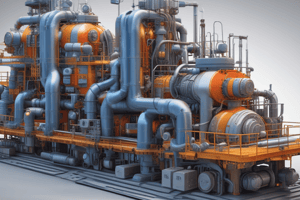Podcast
Questions and Answers
What is a key factor in determining the economical viability of injection molding?
What is a key factor in determining the economical viability of injection molding?
- The color of the finished product
- The temperature of the molding process
- The size of the production quantity (correct)
- The type of plastic used
What is the purpose of the non-return valve in the injection unit?
What is the purpose of the non-return valve in the injection unit?
- To prevent the melt from flowing backward along the screw threads (correct)
- To mix the plastic pellets with additives
- To regulate the temperature of the molten plastic
- To increase the speed of the injection process
What is the main function of the screw in the injection unit?
What is the main function of the screw in the injection unit?
- To heat the plastic pellets
- To mix the plastic pellets with additives
- To cool the molten plastic
- To rapidly move forward to inject molten plastic into the mold (correct)
What is the primary responsibility of the clamping unit in the injection molding process?
What is the primary responsibility of the clamping unit in the injection molding process?
What is the injection unit similar to in terms of its functionality?
What is the injection unit similar to in terms of its functionality?
What is the primary source of plastic material for the injection molding process?
What is the primary source of plastic material for the injection molding process?
What is the primary purpose of heating a thermoplastic?
What is the primary purpose of heating a thermoplastic?
What is the classification of plastic-shaping processes based on?
What is the classification of plastic-shaping processes based on?
Which of the following products is NOT typically made through plastic-shaping processes?
Which of the following products is NOT typically made through plastic-shaping processes?
What is the effect of polymer viscosity on the flow of the polymer melt?
What is the effect of polymer viscosity on the flow of the polymer melt?
Which of the following plastic-shaping processes produces continuous extruded products with constant cross-section?
Which of the following plastic-shaping processes produces continuous extruded products with constant cross-section?
What is the term for the softened state of a thermoplastic that is ready to be shaped?
What is the term for the softened state of a thermoplastic that is ready to be shaped?
What are the benefits of the inherent properties of materials used in injection molding?
What are the benefits of the inherent properties of materials used in injection molding?
What is a major limitation of injection molding?
What is a major limitation of injection molding?
What type of plastics is compression molding used for?
What type of plastics is compression molding used for?
What is the main difference between compression molding and transfer molding?
What is the main difference between compression molding and transfer molding?
What is a benefit of transfer molding over compression molding?
What is a benefit of transfer molding over compression molding?
What type of products are typically produced using compression molding?
What type of products are typically produced using compression molding?
What is the primary method of cooling the film or sheet after extrusion?
What is the primary method of cooling the film or sheet after extrusion?
What is the primary purpose of blow molding?
What is the primary purpose of blow molding?
What is the difference between extrusion blow molding and injection blow molding?
What is the difference between extrusion blow molding and injection blow molding?
In thermoforming, what is the first step in the process?
In thermoforming, what is the first step in the process?
What is the typical thickness range of sheets?
What is the typical thickness range of sheets?
What is the purpose of the parison in blow molding?
What is the purpose of the parison in blow molding?
What is the primary purpose of rotating the mold during the heating phase in rotational molding?
What is the primary purpose of rotating the mold during the heating phase in rotational molding?
What is a limitation of plastic materials that designers must consider?
What is a limitation of plastic materials that designers must consider?
Why was rotational molding little used in the early years after its introduction in the 1940s?
Why was rotational molding little used in the early years after its introduction in the 1940s?
What is the result of improvements in process control and developments with plastic powders in rotational molding?
What is the result of improvements in process control and developments with plastic powders in rotational molding?
What is the purpose of continuing to rotate the mold during the cooling phase in rotational molding?
What is the purpose of continuing to rotate the mold during the cooling phase in rotational molding?
What is a consideration that designers must take into account when working with plastic materials?
What is a consideration that designers must take into account when working with plastic materials?
Flashcards are hidden until you start studying
Study Notes
Plastics Shaping Processes
- Plastics can be shaped into a wide variety of products, such as molded parts, extruded sections, films, and sheets, insulation coatings, and fibers for textiles.
- Plastic-shaping processes can be classified into 8 types based on the resulting geometry:
- Continuous extruded products with constant cross section
- Continuous sheets or films
- Continuous fibers (filaments)
- Solid molded parts
- Hollow molded parts
- Discrete parts made of formed sheets or films
- Castings
- Foamed products
The Polymer Melt and its Properties
- To shape a thermoplastic, it must be heated to a softened consistency, called the polymer melt.
- Important properties of the polymer melt include:
- Viscosity, which affects the flow of the polymer in the cavity or extruder channels.
- The polymer melt can be mixed with fillers such as glass, asbestos, talc, and carbon to enhance its properties.
Limitations of Injection Molding
- Intense industry competition can result in low profit margins.
- Mold costs are high.
- Molding machinery and auxiliary equipment costs are high.
- Lack of knowledge about the fundamentals of the process can cause problems.
- Lack of knowledge about the long-term properties of the materials may result in long-term failures.
Types of Molding Processes
- Compression molding is used for thermosetting plastics and produces a wide variety of products, including electrical and domestic fittings.
- Transfer molding is used for thermosetting plastics and produces parts with small metal inserts and varying section thickness.
- Rotational molding is used to produce hollow objects, such as containers and toys, and is economical for large production quantities.
Product Design Considerations
- Designers must be aware of the limitations of plastic materials, including:
- Strength and stiffness
- Impact resistance
- Service temperatures
- Thermal expansions
- Degradation
Injection Molding Process & Equipment
- Injection molding equipment evolved from metal die casting.
- The injection molding machine consists of two principal components: the plastic injection unit and the mold clamping unit.
- The plastic injection unit is similar to an extruder and consists of a barrel, screw, and non-return valve.
- The clamping unit operates the mold.
Film and Sheet Extrusion
- Sheets have a thickness ranging from 0.5 mm to 12.5 mm.
- Films have a thickness below 0.5 mm.
- The method of manufacturing is similar for both, using conventional extrusion.
- Cooling methods include water quenching and chill rolls.
Blown-Film Process
- Blown-film extrusion uses air pressure to form thin tubes.
- Used for high production of thin tubular films.
Blow Molding
- Blow molding is a molding process that uses air pressure to inflate soft plastic inside a mold cavity.
- Used for producing high quantities of thin-wall products, such as bottles.
- Consists of two steps: production of a starting tube (parison) and inflation of the tube to the desired final shape.
Thermo-Forming
- Thermoforming is a process that heats and deforms a flat thermoplastic sheet into the desired shape.
- Used for packaging and fabrication of large items, such as bath tubs and refrigerators.
- Consists of two main steps: heating the plastic sheet and deforming it into the desired shape.
Studying That Suits You
Use AI to generate personalized quizzes and flashcards to suit your learning preferences.



